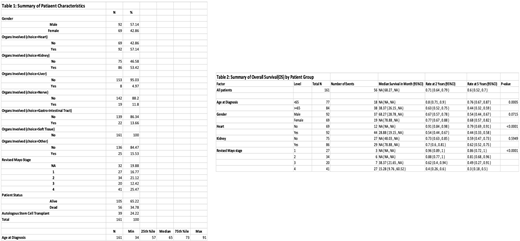Background:
Light Chain (AL) amyloidosis is the most common form of systemic amyloidosis and refers to the deposition of abnormally folded monoclonal light chains or their fragments which can cause organ dysfunction. While treatment with autologous stem cell transplantation needs to be considered in patients who qualify, the increased use of proteasome inhibitors in the past decade has led to deeper hematologic and organ responses. Daratumumab, a CD-38 monoclonal antibody, has also showed promising therapeutic benefit. Given the major advances in AL amyloidosis, our objective was to evaluate presentations, management, and outcomes in AL amyloidosis patients diagnosed from January 2012-April 2020 at our institution.
Methods:
The Cleveland Clinic electronic medical record was queried to identify patients with a confirmed diagnosis of AL amyloidosis from January 2012 until April 2020. All patients over the age of 18 who followed up at the Cleveland Clinic after their initial diagnosis were included. Of 255 patients that were initially queried, 161 were ultimately able to be evaluated and met inclusion criteria. Clinical data was reviewed by authors D.B. and J.T. and conflicts were resolved by consensus. The primary endpoint was overall survival (OS).
Results:
A total of one hundred sixty-one patients were evaluated with baseline characteristics in Table 1. Among them, 92 (57.14%) were males, 69 (42.86%) were females, 92 (57.14%) had cardiac involvement at diagnosis, and 86 (53.42%) had kidney involvement at diagnosis. Also, 61 patients (37.89%) had a Revised Mayo stage of 3 or 4 at diagnosis. Thirty-nine patients (24.22%) underwent autologous stem cell transplantation as part of their treatment regimen. The two-year overall survival (OS) rate was 0.71 (95%CI: 0.64-.79), five-year OS rate was 0.60 (95%CI:0.52-0.69), and the median OS was not reached in this cohort of patients (Table 2). OS was also evaluated by patient group (Table 2).
Conclusion:
Given the recent major advancements in the treatment of AL amyloidosis, we evaluated the presentation, treatment, and outcomes in 161 patients with a diagnosis of AL amyloidosis at the Cleveland Clinic from January 2012-April 2020. A wide variety of patients with AL amyloidosis were evaluated and overall survival by patient group showed significantly better OS in patients age <65 at diagnosis, patients without cardiac involvement, and patients with Revised Mayo stage 2 or less at diagnosis, with a five-year overall response rate of 0.60(95%CI:0.52-0.69) for all patients. Our patient experience highlights the efficacy of proteasome inhibitor use in the past decade for the treatment of AL amyloidosis and also reflect the use of newer agents such as daratumumab. While many major milestones have been achieved in the treatment of AL amyloidosis, more data is needed to assess the optimal duration and appropriate setting for newer therapeutics for this formidable disease.
Valent:Takeda Pharmaceuticals: Other: Teaching, Speakers Bureau; Amgen Inc.: Other: Teaching, Speakers Bureau; Celgene: Other: Teaching, Speakers Bureau.
Author notes
Asterisk with author names denotes non-ASH members.


This feature is available to Subscribers Only
Sign In or Create an Account Close Modal